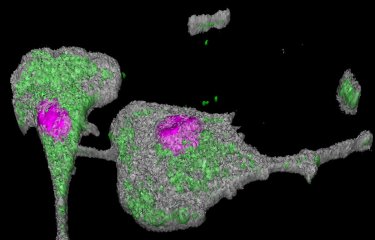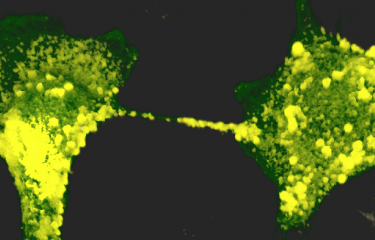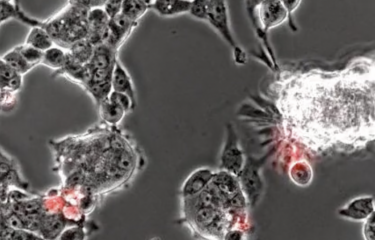Replication of SARS-CoV-2, the virus responsible for COVID-19, depends on a series of interactions between viral proteins and different cellular partners such as nucleic acids (DNA or RNA). Characterizing these interactions is crucial to elucidate the process of viral replication and identify new drugs for treating COVID-19.
An interdisciplinary consortium of scientists from the Institut Pasteur, the Ecole Polytechnique, the Institut Curie, Inserm, the CNRS and the universities of Paris, Paris-Saclay, Bordeaux and Toulouse have demonstrated a specific interaction between a domain of a SARS-CoV-2 protein (Nsp3) and unusual DNA or RNA structures known as G-quadruplexes or G4s. "Using a broad range of experimental approaches, we characterized this interaction and revealed that this Nsp3 protein domain has a clear G4 propensity. We also showed that G4 ligands [chemical compounds that bind with G4s] prevent this interaction," explains Marc Lavigne, a scientist in the Department of Virology at the Institut Pasteur and coordinator of the G4-Covid19 project. These results were recently published in Nucleic Acids Research.
Potential therapeutic application patented
Alongside this study, some G4 ligands were developed by the co-authors* of the article. In a cellular system reproducing SARS-CoV-2 infection, the Institut Pasteur (Marc Lavigne, Hélène Munier-Lehmann, Jeanne Chiavarelli and Björn Meyer) demonstrated that these ligands, which prevent interaction between the SARS-CoV-2 protein and the G4 structure, exhibit antiviral activity.
These results pave the way for the use of G4-binding molecules as potent antiviral compounds (European patent 20 306 606.3 and Institut Pasteur DI 2020-59) and confirm the choice to target host-virus interactions in antiviral strategies.
The project received financial support from the Institut Pasteur (via the exceptional COVID-19 program, funded in part by donations), the French National Research Agency (ANR-Flash-Covid) and own funding from the various laboratories involved. It also involved the participation of several of the Institut Pasteur's technological platforms (PF-BMI, PF-3PR and PF-CCB).
* The teams led by Professor Jean Guillon at the University of Bordeaux (ARNA, U1212 Inserm and UMR5320 CNRS) and those led by Dr. Jean-Louis Mergny at the Ecole Polytechnique (LOB, UMR7645 CNRS and U1182 Inserm).
This study is part of the priority scientific area Emerging infectious diseases of the Institut Pasteur's strategic plan for 2019-2023.
Source:
SARS-CoV-2 Nsp3 Unique Domain SUD interacts with Guanine quadruplexes and G4-ligands inhibit this interaction, Nucleic Acids Res., July 7, 2021
https://doi.org/10.1093/nar/gkab571
Lavigne M1,*, Helynck O2, Rigolet P3, Boudria-Souilah R.1, Nowakowski M4, Baron B5 , Brülé S5, Hoos S5, Raynal B5, Guittat L6,7, Beauvineau C3, Petres S4, Granzhan A3, Guillon J8, Pratviel G9, Teulade-Fichou MP3, England P5,*, Mergny JL7,*,Munier-Lehmann H2,*.
* : corresponding authors
1Institut Pasteur, D´epartement de Virologie. CNRS UMR 3569, Paris, France,
2Institut Pasteur, Unité de Chimie et Biocatalyse. CNRS UMR 3523, Paris, France,
3Institut Curie, Université Paris-Saclay, CNRS UMR 9187, Inserm U1196, Orsay, France,
4Institut Pasteur, Plateforme de Production et Purification de Prot ´eines Recombinantes, C2RT, CNRS UMR 3528, Paris, France,
5Institut Pasteur, Plateforme de Biophysique Moléculaire, C2RT, CNRS UMR 3528, Paris, France, 6Université Sorbonne Paris Nord, INSERM U978, Labex Inflamex, F-93017 Bobigny, France,
7Laboratoire d’optique et Biosciences, Ecole Polytechnique, Inserm U1182, CNRS UMR7645, Institut Polytechnique de Paris, Palaiseau, France,
8Inserm U1212, CNRS UMR 5320, Laboratoire ARNA, UFR des Sciences Pharmaceutiques, Université de Bordeaux, Bordeaux, France
9CNRS UPR 8241, Université Paul Sabatier, Laboratoire de Chimie de Coordination, Toulouse, France





